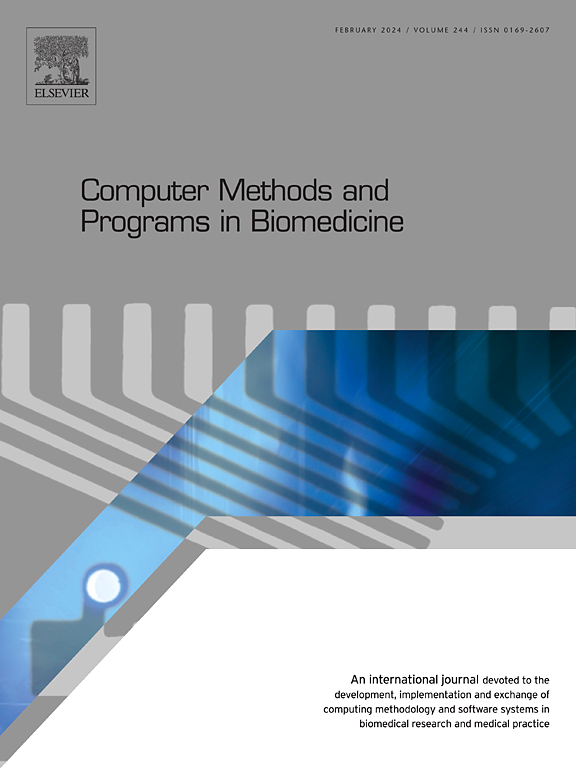交叉融合自适应特征增强变压器:高效高频整合和稀疏注意力增强脑MRI超分辨率
IF 4.8
2区 医学
Q1 COMPUTER SCIENCE, INTERDISCIPLINARY APPLICATIONS
引用次数: 0
摘要
背景和目的:高分辨率磁共振成像(MRI)是诊断和治疗脑部疾病的必要手段。基于变压器的方法通过有效捕获远程依赖关系,在MRI超分辨率中显示出强大的潜力。然而,现有的基于变压器的超分辨方法面临着以下几个挑战:(1)主要关注低频信息,忽视了高频信息的利用;(2)缺乏整合低频和高频信息的有效机制;(3)在重建过程中难以有效消除冗余信息。为了解决这些问题,我们提出了交叉融合自适应特征增强变压器(CAFET)。方法:我们的模型最大化了cnn和transformer的潜力。它由四个关键块组成:用于提取高频信息的高频增强块;用于捕获全局信息和局部拟合的混合注意块,包括通道注意和移位矩形窗口注意;一种融合局部高频特征和全局低频特征的大窗口融合注意块;采用自适应稀疏重叠注意块,动态保留关键信息,增强交叉窗口特征的聚集性。结果:大量的实验验证了该方法的有效性。在BraTS和IXI数据集上,与最先进的方法相比,该方法的上采样因子为×2,最大PSNR提高了2.4 dB和1.3 dB, SSIM提高了0.16%和1.42%。同样,在上采样因子为×4的情况下,该方法的最大PSNR比目前领先的方法提高了1.04 dB和0.3 dB, SSIM提高了0.25%和1.66%。结论:该方法能够重建高质量的超分辨率脑MRI图像,具有重要的临床应用潜力。本文章由计算机程序翻译,如有差异,请以英文原文为准。
Cross-Fusion Adaptive Feature Enhancement Transformer: Efficient high-frequency integration and sparse attention enhancement for brain MRI super-resolution
Background and Objectives:
High-resolution magnetic resonance imaging (MRI) is essential for diagnosing and treating brain diseases. Transformer-based approaches demonstrate strong potential in MRI super-resolution by capturing long-range dependencies effectively. However, existing Transformer-based super-resolution methods face several challenges: (1) they primarily focus on low-frequency information, neglecting the utilization of high-frequency information; (2) they lack effective mechanisms to integrate both low-frequency and high-frequency information; (3) they struggle to effectively eliminate redundant information during the reconstruction process. To address these issues, we propose the Cross-fusion Adaptive Feature Enhancement Transformer (CAFET).
Methods:
Our model maximizes the potential of both CNNs and Transformers. It consists of four key blocks: a high-frequency enhancement block for extracting high-frequency information; a hybrid attention block for capturing global information and local fitting, which includes channel attention and shifted rectangular window attention; a large-window fusion attention block for integrating local high-frequency features and global low-frequency features; and an adaptive sparse overlapping attention block for dynamically retaining key information and enhancing the aggregation of cross-window features.
Results:
Extensive experiments validate the effectiveness of the proposed method. On the BraTS and IXI datasets, with an upsampling factor of , the proposed method achieves a maximum PSNR improvement of 2.4 dB and 1.3 dB compared to state-of-the-art methods, along with an SSIM improvement of up to 0.16% and 1.42%. Similarly, at an upsampling factor of , the proposed method achieves a maximum PSNR improvement of 1.04 dB and 0.3 dB over the current leading methods, along with an SSIM improvement of up to 0.25% and 1.66%.
Conclusions:
Our method is capable of reconstructing high-quality super-resolution brain MRI images, demonstrating significant clinical potential.
求助全文
通过发布文献求助,成功后即可免费获取论文全文。
去求助
来源期刊

Computer methods and programs in biomedicine
工程技术-工程:生物医学
CiteScore
12.30
自引率
6.60%
发文量
601
审稿时长
135 days
期刊介绍:
To encourage the development of formal computing methods, and their application in biomedical research and medical practice, by illustration of fundamental principles in biomedical informatics research; to stimulate basic research into application software design; to report the state of research of biomedical information processing projects; to report new computer methodologies applied in biomedical areas; the eventual distribution of demonstrable software to avoid duplication of effort; to provide a forum for discussion and improvement of existing software; to optimize contact between national organizations and regional user groups by promoting an international exchange of information on formal methods, standards and software in biomedicine.
Computer Methods and Programs in Biomedicine covers computing methodology and software systems derived from computing science for implementation in all aspects of biomedical research and medical practice. It is designed to serve: biochemists; biologists; geneticists; immunologists; neuroscientists; pharmacologists; toxicologists; clinicians; epidemiologists; psychiatrists; psychologists; cardiologists; chemists; (radio)physicists; computer scientists; programmers and systems analysts; biomedical, clinical, electrical and other engineers; teachers of medical informatics and users of educational software.
 求助内容:
求助内容: 应助结果提醒方式:
应助结果提醒方式:


